350 Search Results for aided language input
December 13, 2012
by Robin Parker -
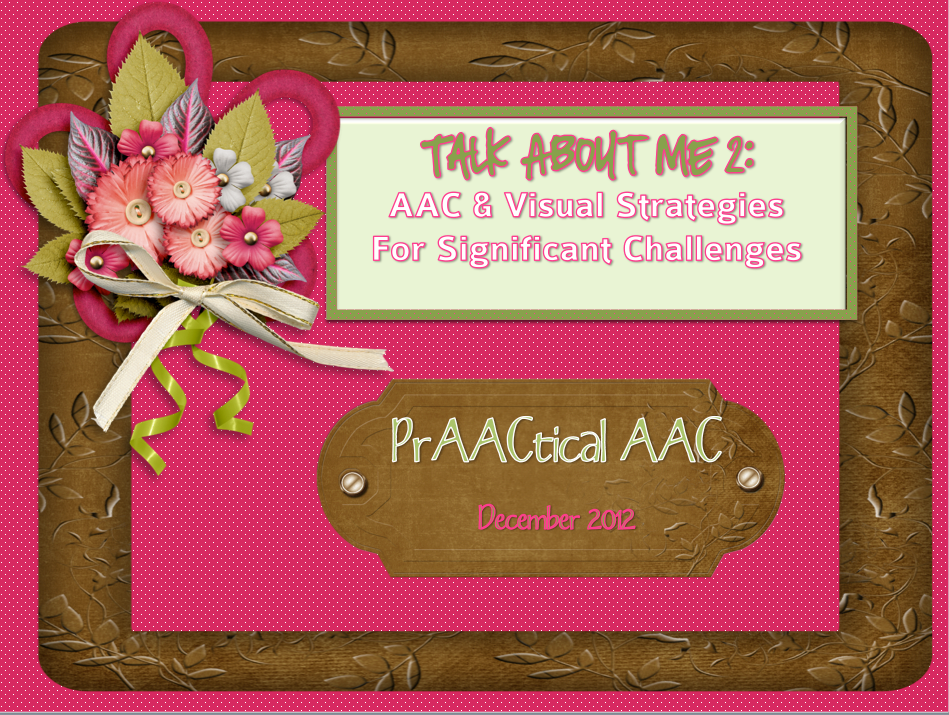
We write about a lot of AAC strategies and we often give examples of different types of learners. Sometimes the learners we work with have more challenges than we explain. Lest you think, we do not see the really ‘challenging’ learners, we do, we really do. For those individuals with more challenges than most, sometime we are asked, well what do a few visual supports or AAC strategies do? What difference do they make? The truthful answer is A LOT. Here are a just a few recent examples from some really amazing families. When a mom is on the phone, a young adult brings in a timer and sets it so mom will get off the phone and go sit with her. When a communication book is forgotten on an emergency trip to the dentist, drawing on a napkin is enough to keep everyone calm so that the dentist can... [Read More...]
December 5, 2012
by Robin Parker -
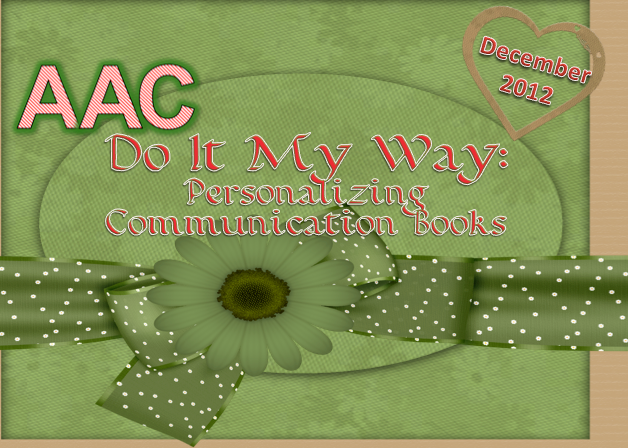
The topic of communication books was introduced this month. We will continue to think about the multitude of decisions to make as we design individual communication books. Obviously, content is the most important issue, but we are often reminded that function and form must go together. Carole gave some great examples of reasons to make the books appealing and personal. I had a situation this week that illustrated this concept perfectly. We continue to learn from the ‘learners’ that we are teaching. I know a little girl with autism who most people think does not care about her peers or how things look. She uses some natural speech and a no-tech communication book. She uses the communication book during her speech-language therapy sessions but only inconsistently outside of the therapy room. She has not expressed interest in taking the communication book with her and although she has some specific visual... [Read More...]
December 1, 2012
by Carole Zangari -

There’s something about the month of December that makes us a bit nostalgic. As we prepare for the holidays, our thoughts drift to the past. Simpler times. Tradition. The way things used to be. And, so, for our Strategy of the Month, we step away from the latest app or fanciest SGD and turn our attention to one of the tried-and-true tools from the past: Communication books. They used to be ubiquitous but now they’re becoming almost a rarity. We’ve decided to focus on them for a couple of reasons, but the main one is to spread the word that it doesn’t take a sizeable budget to give someone access to real language. If you have access to a computer and printer, you can make a really robust communication book for little or no money. It seems so simple: Put some words and pictures in a book. Show someone how... [Read More...]
November 20, 2012
by Robin Parker -
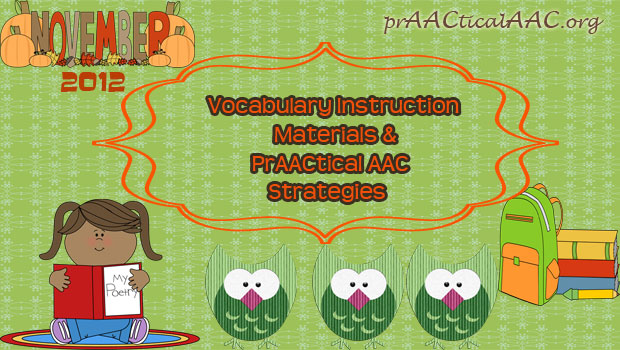
We are super big fans of Teachers Pay Teachers (TPT). We need the PrAACtical resources that TPT offers. In addition to paying ridiculously low prices for some great teaching materials and cool classroom resources, there are also many free options. Check out these free vocabulary resources and have lots of fun. As always, the materials are only as good as the teaching strategies that go with them. As we check out these awesome vocabulary resources, we will use the following guiding principles and we will create appropriate communication opportunities for ALL learners to participate in direct vocabulary instruction. Active Participation for Everyone– Make sure all learners can make choices within the activity, respond to questions, add information, request clarification, and even ask for a break if they need it. To do this we will need one hit message devices, visual supports, individual and group communication displays, choice boards, switches, etc.... [Read More...]
November 20, 2012
by Carole Zangari -
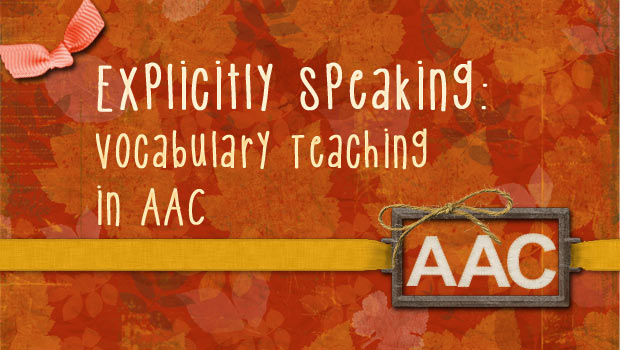
An essential part of the model we shared for AAC semantic intervention is Step 2, teaching the new words with explicit instruction activities. In our posts, explicit instruction refers to the process of designing and using carefully planned sequence of empirically-supported teaching activities. Though focused on reading, not vocabulary, development, this PowerPoint presentation by Dr. Anita Archer gives an excellent overview of the characteristics of explicit instruction. In our initial teaching of new words, we to be sure that the learners have frequent opportunities to respond: Active participation is critical at this point. We have to give the learner a lot of opportunities to say the word (e.g.,“resume”) and tell about it (e.g., “keep going,” “start again and not stop,” “verb”, etc.). We want to elicit a lot of responses so that we can monitor their performance. That allows us to provide feedback that is affirmative when the learners respond... [Read More...]
November 10, 2012
by Robin Parker -
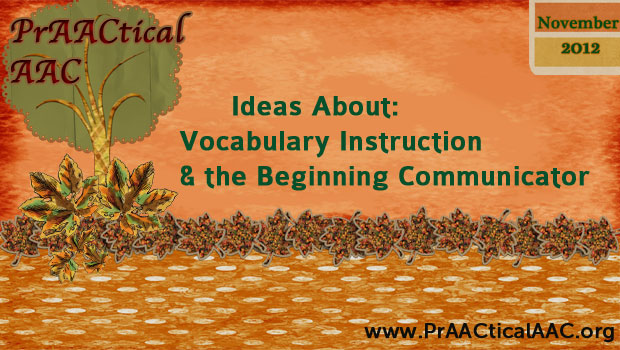
Vocabulary instruction is a topic not often discussed for beginning communicators. As we work with beginning communicators the primary focus is often vocabulary selection for communication displays. This is understandable as the beginning communicator has many needs, but that is no excuse for leaving out vocabulary instruction. Direct vocabulary instruction helps expand broader vocabulary selection options, literacy skills, and world knowledge. With that in mind, see below for vocabulary instruction philosophies, notes, and activities for the beginning communicator. Please let us know about your favorite vocabulary instruction activities. Vocabulary Instruction for the Beginning Communicator: 5 Philosophies Vocabulary instruction involves a systematic TEACHING process. Add vocabulary as an activity on the daily schedule and then have a mini-schedule for the specific vocabulary instruction activities for that day. Carole introduced general steps for vocabulary instruction last week. For the beginning communicator, also apply an errorless learning paradigm. Gradually, add comprehension checks, but... [Read More...]
November 9, 2012
by Carole Zangari -

No matter where they work, SLPs supporting people who use AAC generally do what they can to improve communication across environments. In an earlier Simple Start post, we talked about using photos of places within a school to support language comprehension. By showing a picture of the cafeteria or gym as we say those words, we can help both students with language processing difficulties and those with behavior regulation issues. — In this post, we extend the same concept to travels in and around the community. Here are directions for making visual supports that can be used with students who have community-based instruction or by families as they go about their weekly errands and routines. Simple Start: Visual Support for Places in the Community Take photo of locations in the community that the AAC user is likely to visit. Insert them into a document and add labels for each one... [Read More...]
November 3, 2012
by Carole Zangari -
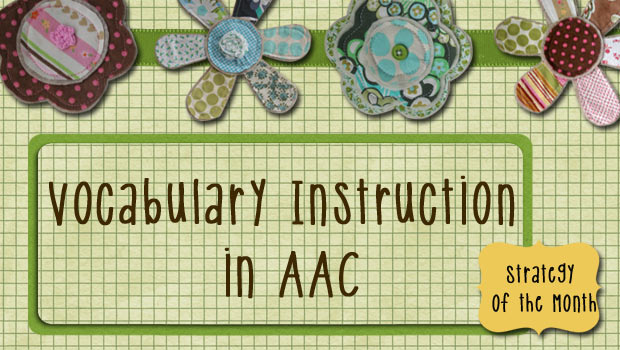
For all of us, the process of how we learn to use words begins with the expression of our own intents. Initially, we use words, pictures, or signs to make our wants/needs known but that soon develops into social exchanges, true conversations, stories, and more. For some of our AAC friends, the path to a rich lexicon can be convoluted and bumpy. Our November Strategy of the Month posts will focus on vocabulary instruction giving both general principles that should guide our teaching and specific considerations for communicators at different levels. As SLPs, we should be champions for a comprehensive approach to semantic instruction in AAC. Much of what we already know for teaching semantics to people who speak can be applied quite nicely to individuals with AAC needs. Certainly some things will need to be adapted, but that’s not the real issue. We’ve noticed that SLPs sometimes forget to... [Read More...]
October 30, 2012
by Carole Zangari -
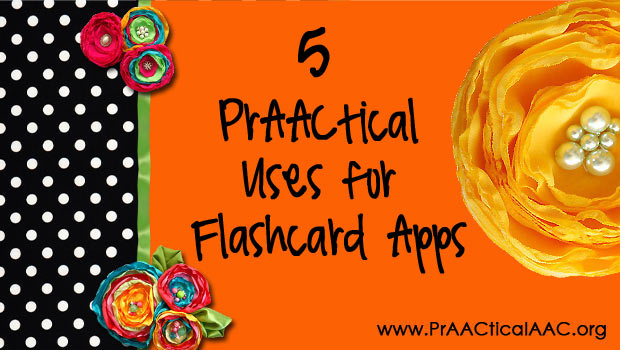
We love AAC intervention that begins and ends with a context that is meaningful to the learner. Not only is contextually relevant therapy more engaging and fun for the learner (thus, easier on the clinician!) but it promotes generalization to real-world contexts. So we’ve never been terribly fond of therapy that uses flash cards, or, more recently, the digital versions on iOS or Android devices. It’s a shame, really. There are a lot of those kinds of apps, and many of them have great graphics. That got us to starting thinking: What could we use them for that improves real communication and AAC learning? PrAACtical Uses for Flashcard Apps Make a Mini Schedule: Lots of people with AAC needs use paper-based picture schedules that depict the activities they do throughout the day. A flashcard app could be used in conjunction with those to show the steps or parts of an... [Read More...]
October 28, 2012
by Carole Zangari -

We mean well. We really do. But sometimes the things we say or do, and even the things we DON’T say/do have a negative impact on our long-range goal of improving AAC outcomes. Here are some of the things we’ve observed that can discourage AAC use. Recommending AAC without giving stakeholders a solid, evidence-based rationale creates a shaky foundation. People aren’t going to put forth effort to implement something they don’t believe in, and they won’t believe in it until we make a compelling, well-supported argument. ‘Rules that aren’t understood are the first to be broken.’ It’s easy to forget that, in some ways, the AAC user is learning a whole new language. What would it take US to learn a new language? Well, for starters, we’d want to be immersed into an environment with competent speakers of that language. Hearing the language that we’re trying to learn makes... [Read More...]









